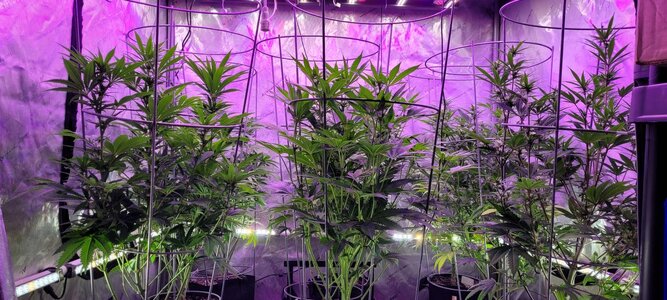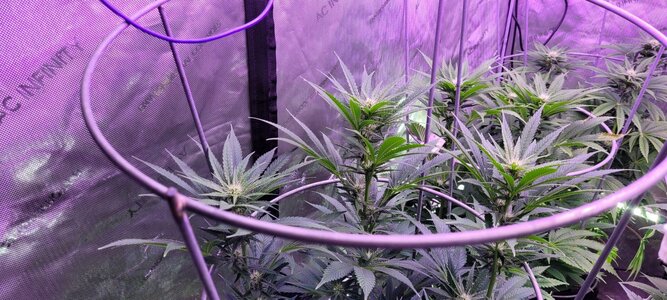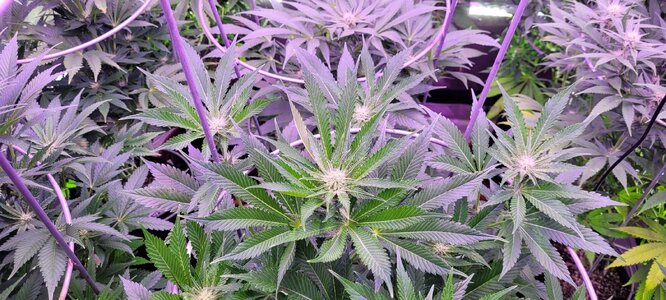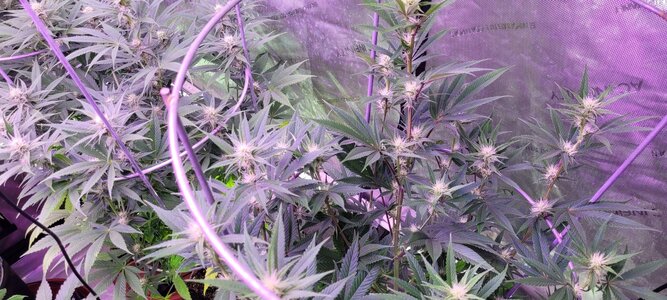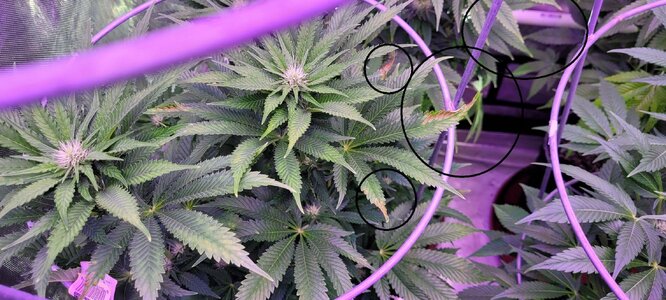MiGrampa
Herb Hitman
- Joined
- May 18, 2023
- Messages
- 668
- Reaction score
- 2,844
Follow along with the video below to see how to install our site as a web app on your home screen.

Note: This feature currently requires accessing the site using the built-in Safari browser.
ive done it before in a sandwhich baggy with damp paper towel, surely #/10 will throw a root while shipping.
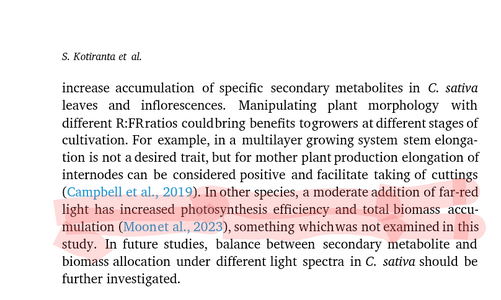
I'm interested in hearing where all this is leading us. Being able to utilize the different light frequencies to manipulate how cannabis grows has been fascinating so far. I wonder what Dr. Bugbee has to say on the topic?Trying to go through that study and not sure I follow this last part correctly. I guess it's saying that usually far red is good, for other species.View attachment 93735
I can't get over the dramatic changes in morphology in the pictures in the study. Like obviously that is too much far red if it looks like a Charlie Brown Christmas tree.
This study is a hard pill to swallow
That's quite possible. The study did not say UV light has no effect. It says it didn't make a noticeable difference in an indoor cannabis grow. The variables might be different with UV at high elevation ... @Observer I can get behind that hypothesis. Has there been any recent studies of outdoor cannabis and uv exposure when grown at high elevations?i heard/ hypothesized UV may have more of an effect on plants that evolved at higher elevations, due to UV getting through the atmosphere "easier" , as its thinner, and does not block as much radiation.
ill try to find where i saw that atThat's quite possible. The study did not say UV light has no effect. It says it didn't make a noticeable difference in an indoor cannabis grow. The variables might be different with UV at high elevation ... @Observer I can get behind that hypothesis. Has there been any recent studies of outdoor cannabis and uv exposure when grown at high elevations?
Here's what Claude AI had to say ...ill try to find where i saw that at
ill try to find where i saw that at
i said it here for some reason, i dont think i came up with that hypothesis, maybe i did, but i thought i read it in a another paper or somewhere.Here's what ChatGPT had to say:
Has there been any recent studies of outdoor cannabis and uv exposure when grown at high elevations.
Recent studies have explored the effects of ultraviolet (UV) radiation on cannabis plants, though specific research on outdoor cultivation at high elevations remains limited. In controlled indoor environments, increased UV exposure has been linked to various plant responses. For instance, a study found that higher UV levels led to reduced plant size, leaf malformations, and decreased photosynthetic rates, without significant benefits to cannabinoid concentrations.
frontiersin.org
Another investigation reported minimal effects on cannabinoid content when plants were subjected to elevated UV photon fluxes, suggesting that higher UV levels do not necessarily enhance cannabinoid synthesis.
frontiersin.org
While direct studies on outdoor cannabis cultivation at high elevations are scarce, it's known that UV radiation intensity increases with altitude. This heightened UV exposure can influence cannabis plants, potentially affecting resin production and secondary metabolite profiles. However, excessive UV exposure may also harm plant health, causing issues like sunburn.
floraflex.com
Additionally, cannabis strains adapted to high-altitude environments often exhibit unique characteristics, such as lighter-colored leaves to reflect intense sunlight and enhanced cannabinoid and terpene profiles.
mountainanniescannabis.com
In summary, while indoor studies provide insights into UV radiation's impact on cannabis, more research is needed to fully understand how outdoor cultivation at high elevations affects plant development and chemical composition.
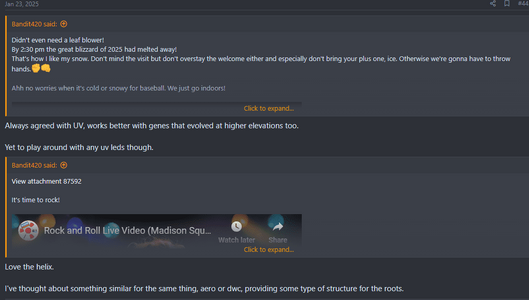
Key Points:
In summary:
- High-Elevation Adaptations:
- Plants in high-altitude environments have undergone evolutionary adaptations to withstand intense UV radiation, among other stressors. These adaptations often involve genetic modifications that enhance their ability to produce protective compounds.
- Studies show that these plants frequently exhibit increased production of flavonoids, which act as natural UV protectants. This is a genetic trait that has been selected for over generations.
- UV and Genetic Expression:
- UV radiation can trigger changes in gene expression in plants. This means that exposure to UV can activate or deactivate certain genes, leading to changes in the plant's physiology and biochemistry.
- In plants with high-elevation adaptations, the genes responsible for flavonoid production are often more readily activated by UV exposure. This suggests that their genetic makeup is optimized to respond to UV stress.
- UV LEDs and Research:
- The use of UV LEDs in plant research is becoming increasingly common. This technology allows researchers to precisely control the intensity and wavelength of UV radiation, enabling them to study its effects on plants in a controlled environment.
- Researchers are using UV LEDs to investigate:
- The effects of different UV wavelengths on plant growth and development.
- The mechanisms by which plants perceive and respond to UV radiation.
- The role of UV in the production of secondary metabolites, such as flavonoids and cannabinoids.
- It is very important to note that the effects of UV light are very dependant on the specific wavelengths of UV light being used. UV-A, UV-B, and UV-C all have very different effects on plant life.
- Genetic Predisposition:
- It is very likely that plants that have genetics that have evolved in high altitude environments, will have a greater ability to deal with UV radiation. This is due to the fact that over many generations, those plants that could not deal with the radiation, would die off, and those that could, would reproduce. Thus leading to a genetic line of plants that are better suited to high UV environments.
- The idea that plants with high-elevation genetics respond differently to UV is supported by scientific evidence.
- UV LEDs are valuable tools for studying these interactions.
- It is important to remember that UV radiation effects plant life in very complex ways
i dont think anyone has done the study i mentioned.
he did say, they see anthocyanins going up from the UVso that video, according to research/test/experiments , they are saying they have not seen any THC increase from 400um wavelength uv or less, which makes me sad lol
I have 2 sets of AC Infinity ionbeam 16"(eight 16" lights). They are at the pot level if you go back to yesterday's pictures.hey have you thought about under canopy lighting?
looks appealing.
oof i missed thatI have 2 sets of AC Infinity ionbeam 16"(eight 16" lights). They are at the pot level if you go back to yesterday's pictures.
Still has beneficial germicidal properties right? Like helping to minimize PM?so that video, according to research/test/experiments , they are saying they have not seen any THC increase from 400um wavelength uv or less, which makes me sad lol
It seems to me that nature supplies what nature requires.Still has beneficial germicidal properties right? Like helping to minimize PM?
I really believed, I guess now bro science, that UV could help the plant to produce more oils because of it. Like how humans need UV to produce vitamin D, not enough and we get vitamin D defencies. Just thought there has to be a similar synergistic effect with plants.
Wishing doesn't make science right lol
But there must be more to it
Hey, I've been reading along here. one thing I don't see mentioned is that we give 12 noon high intensity lighting from wake to dark. Out doors the sun is at different angles providing different spectrum's and intensity, would that not also be hard to replace in studies done indoors.Key Points:
In summary:
- High-Elevation Adaptations:
- Plants in high-altitude environments have undergone evolutionary adaptations to withstand intense UV radiation, among other stressors. These adaptations often involve genetic modifications that enhance their ability to produce protective compounds.
- Studies show that these plants frequently exhibit increased production of flavonoids, which act as natural UV protectants. This is a genetic trait that has been selected for over generations.
- UV and Genetic Expression:
- UV radiation can trigger changes in gene expression in plants. This means that exposure to UV can activate or deactivate certain genes, leading to changes in the plant's physiology and biochemistry.
- In plants with high-elevation adaptations, the genes responsible for flavonoid production are often more readily activated by UV exposure. This suggests that their genetic makeup is optimized to respond to UV stress.
- UV LEDs and Research:
- The use of UV LEDs in plant research is becoming increasingly common. This technology allows researchers to precisely control the intensity and wavelength of UV radiation, enabling them to study its effects on plants in a controlled environment.
- Researchers are using UV LEDs to investigate:
- The effects of different UV wavelengths on plant growth and development.
- The mechanisms by which plants perceive and respond to UV radiation.
- The role of UV in the production of secondary metabolites, such as flavonoids and cannabinoids.
- It is very important to note that the effects of UV light are very dependant on the specific wavelengths of UV light being used. UV-A, UV-B, and UV-C all have very different effects on plant life.
- Genetic Predisposition:
- It is very likely that plants that have genetics that have evolved in high altitude environments, will have a greater ability to deal with UV radiation. This is due to the fact that over many generations, those plants that could not deal with the radiation, would die off, and those that could, would reproduce. Thus leading to a genetic line of plants that are better suited to high UV environments.
- The idea that plants with high-elevation genetics respond differently to UV is supported by scientific evidence.
- UV LEDs are valuable tools for studying these interactions.
- It is important to remember that UV radiation effects plant life in very complex ways
They went with 25% ir I think I read.....we're no where close to that. The old blurple lights were all red and blues and they did fine...ishTrying to go through that study and not sure I follow this last part correctly. I guess it's saying that usually far red is good, for other species.View attachment 93735
I can't get over the dramatic changes in morphology in the pictures in the study. Like obviously that is too much far red if it looks like a Charlie Brown Christmas tree.
This study is a hard pill to swallow
